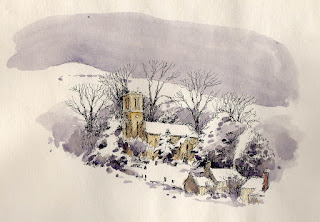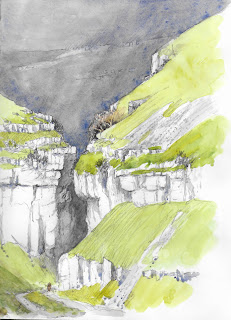I’ve just delivered some paintings to the Attic Gallery in Swansea’s Maritime Quarter for a mixed show running until 26th March, and there are some excellent works on display. You will find the gallery at 37 Pocketts Wharf, SA1 3XL and the telephone number is 01792 653387. My mainly Pembrokeshire scenes includes one of my favourite locations of East Angle Bay.
This watercolour shows a tranquil winter evening with Angle church forming the centre of interest. I’ve kept the main design in harmony with the emphasis on horizontals on the creek, the lie of the land and with the clouds. In the sky the Aussie red gold also has a horizontal bias and is deliberately strong around the lightest part of the sky to heighten the glow. Positioning the church with the creek leading towards it, and the reflected light on the water brings it all together and it is important to ensure that all these varied elements support one another in this way. Sometimes nature needs a little tweaking to produce a good composition.
If you are planning on exploring more of the UK rather than travelling abroad this year you may well find the Great British Wildlife & Environment Map of great help. It features over 1,500 wildlife hotspots, eco events, conservation projects and days out in the natural environment, places where it holds interest for those artists who love to get out amidst nature and perhaps sit quietly to observe wildlife. It has an amazing amount of detail on both sides and is produced by marvellousmaps.com








